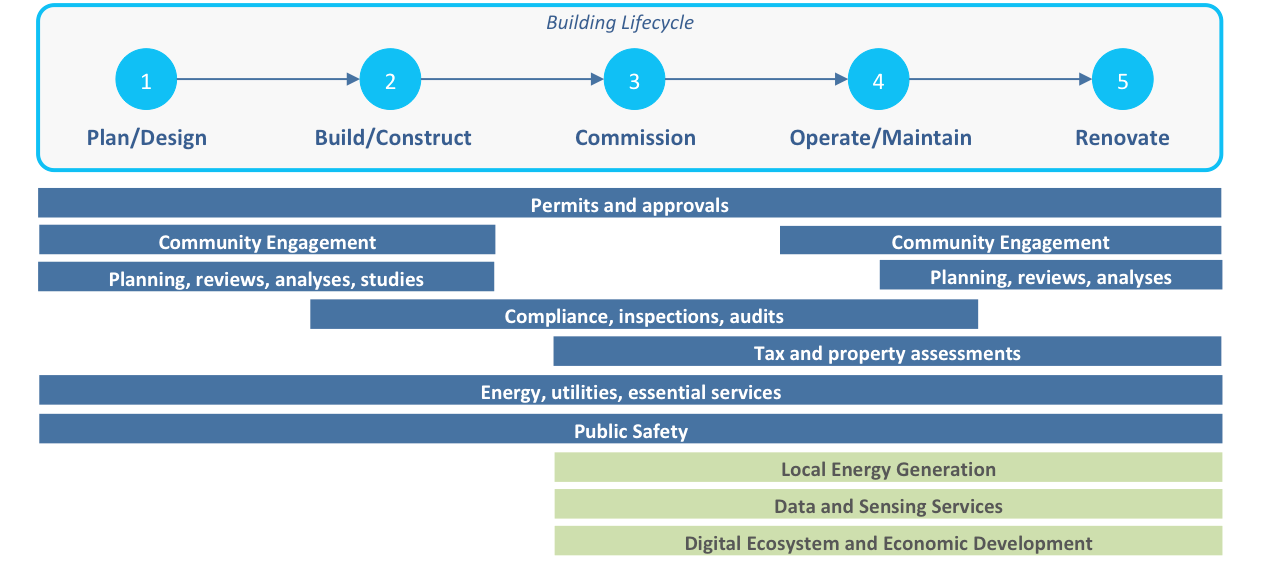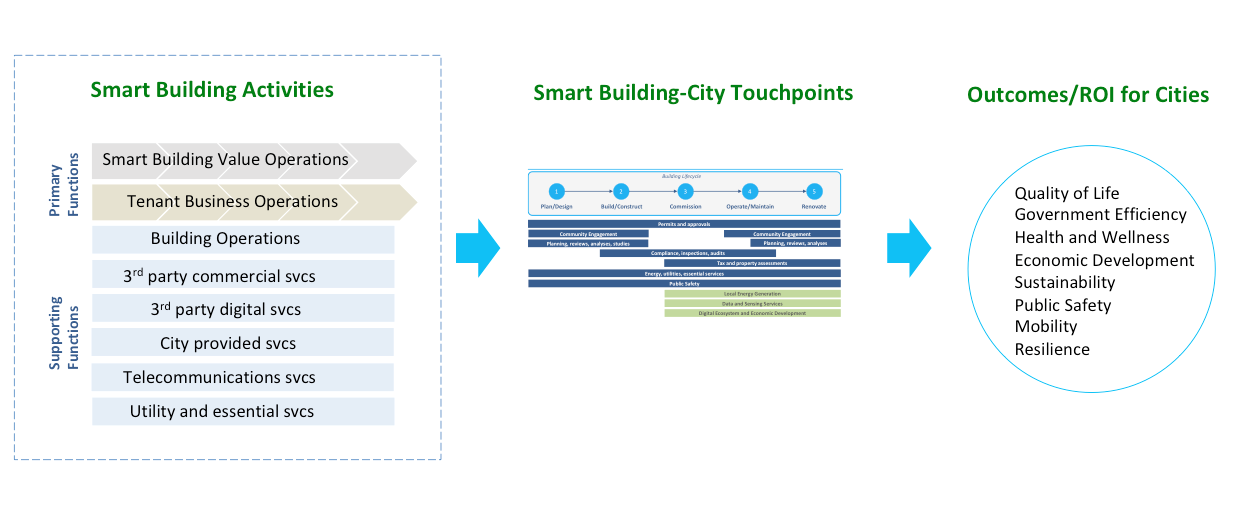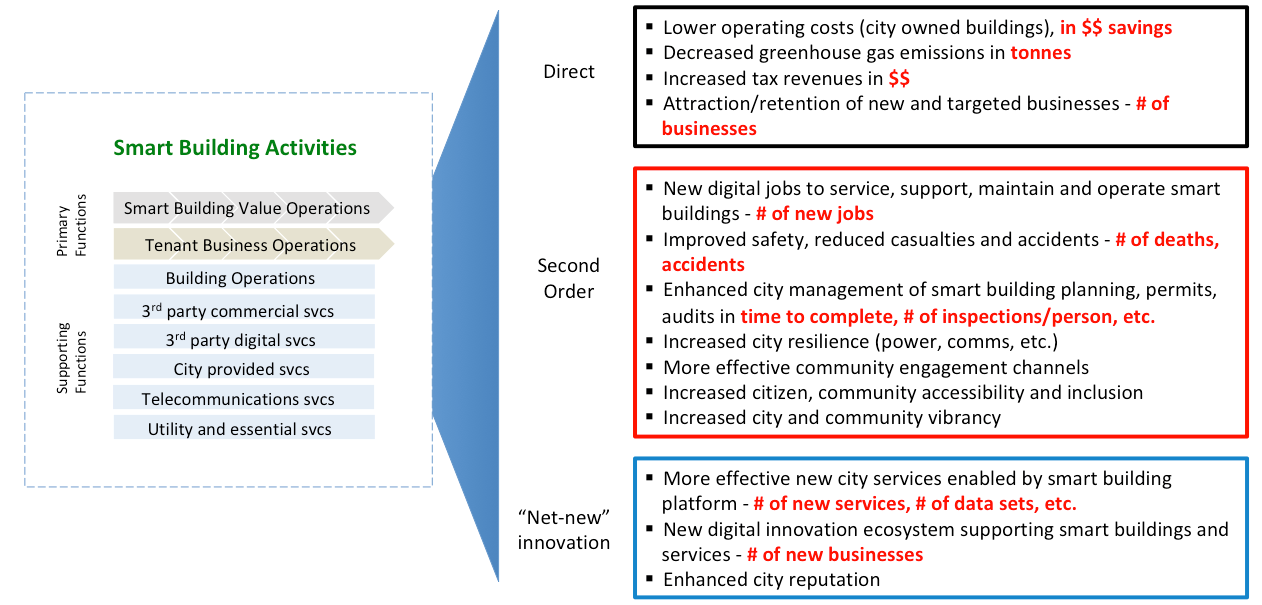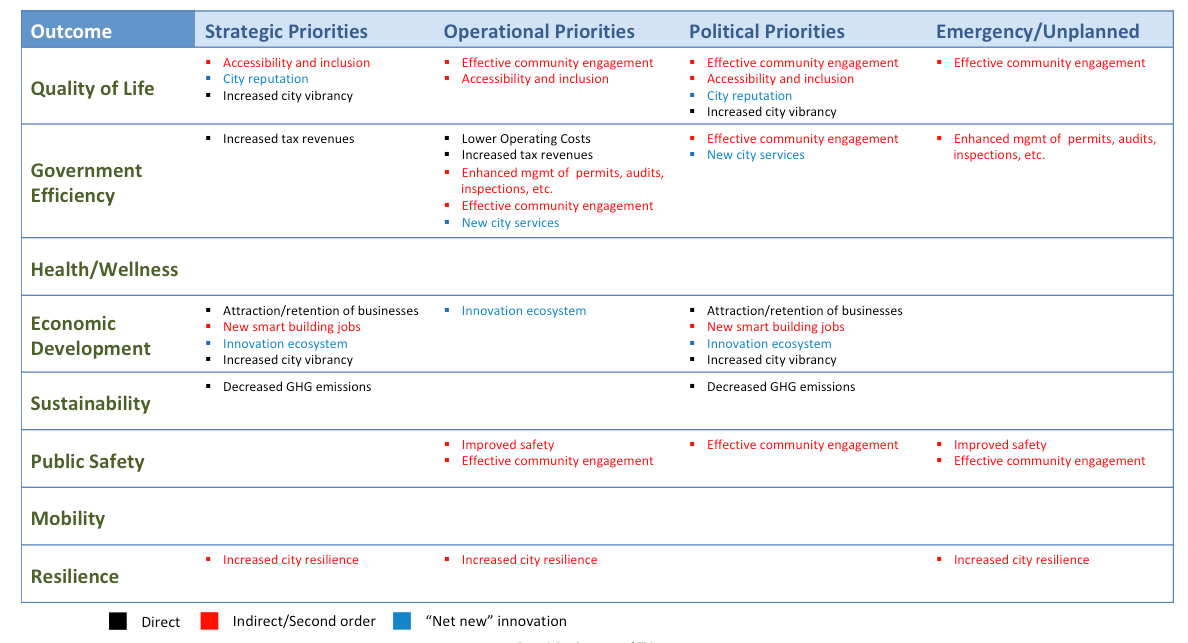Smart buildings – what’s the value to smart cities? Part Two
Smart buildings incorporate advanced digital technologies, algorithms and analytics, to bring new and significant value to tenants, building owners and operators. These benefits range from increased tenant productivity and safety, lower operating costs, and higher satisfaction. What value do cities get from smart buildings? Why should city officials and residents want smart buildings in their cities? Why should cities encourage the development and retrofitting of smart buildings?
While the benefits and Return on Investment (ROI) of smart buildings are well documented for tenants, building owners and operators, similar information for cities are limited at best. In addition, cities measure the benefits and ROI of smart buildings differently, and look beyond financial metrics.
In Part One, we provided an understanding of the types of outcomes cities care about, the role of ROI and types of benefits, and how those benefits are viewed against the four civic dimensions. Part Two provides a framework for identifying areas of value creation and share a sample set of values and benefits for cities. We will leave it to the reader to use the framework and add new benefits and outcomes as appropriate for their situation.
Smart buildings and cities come together at interaction points
We start by identifying the major interaction points between the smart building and the city (Figure Five) over a typical building life cycle. At each stage of the building life cycle, a different set of activities, and interactions, are involved between the smart building, the city, and others in the civic ecosystem. Some of these interactions are identical to those that exist between the city and traditional buildings. However, smart buildings provide additional interactions (highlighted in green), enabled by their advanced energy and digital infrastructures and capabilities. These interactions create new opportunities for value to the city.

These smart building-city interaction points provide the path or channels for the delivery of benefits to the city. But what exactly does a smart building do to create the value that is transferred to the city through these interaction points? Smart buildings create value through direct and indirect activities Civic value creation in a smart building comes from three distinct sets of activities (Figure Six). Tenant business operations and support activities create tangible value for the city indirectly as it carries out its non-city task. On the other hand, smart building value operations are those services directed at the city as the customer.

A smart building creates value by enabling its tenants and other building users to work more effectively, productively and safely on a day-to-day basis than in a non-smart building. In doing so, these tenant activities directly or indirectly contribute new (or more) value for the city that it couldn’t have offered otherwise. For example, tenants are more likely to stay in a smart building longer, be more willing to enter into premium leases, and more likely to expand and hire more employees. This in turn leads to higher assessed building assessed values (and surrounding buildings) and higher property tax revenues for the city. At the same time, a more productive tenant contributes to the development of the local businesses, which leads to increased tax revenues generated from the business ecosystem.
A smart building has a more robust and advanced digital and communications infrastructure than a non-smart building. Its excess capacity can be used by the building owners to create direct outcomes for the benefit of a city. Unlike tenant operational activities which indirectly benefit the city, the smart building value operations are activities that are specifically designed to leverage the building’s capabilities and infrastructure to provide direct value and outcomes to the city. For example, the smart building may use IoT to leverage any excess capacity on this infrastructure to provide data and sensing services to the city. It may do this by hosting an Internet of Things (IoT) sensor network to monitor outside pedestrian and motor vehicle traffic around the building. It may utilize its analytics and data processing capabilities to review the sensor information, create actionable insights, and provide the data directly to the city or the community. A smart building may use the excess energy produced by its solar panels and provide it back into a local microgrid to meet the demand of its neighbors.
Facilitating tenant operations and smart building value operations is a series of support activities. These range from building maintenance operations to telecommunications services. In a smart building, these supporting activities will also contribute to the attainment of city outcomes. For example, the operation of the smart HVAC system, designed to keep building occupants comfortable, results in decreased energy usage and reduced greenhouse gas emissions. The smart HVAC system, heavily dependent on a new generation of digitally savvy service technicians, results in new “smart” jobs and a supporting digital vendor ecosystem, and creates economic development outcomes.
More about What are Intelligent Buildings and how they are connected
Sample smart building value and benefits for cities
To discuss the benefits of smart buildings to a city, we need to consider a community level metric. A community with a “positive tipping point” of smart buildings leads more easily to being considered a “city of the future”, whereas a few smart buildings can attract new talent and positive taxflow, but by themselves are not enough to create a connected, Smart City. Using the above model and considerations, we review the smart building activities against the city-building touchpoints to identify potential ROI and benefits (Figure Seven). This is not a comprehensive list and there will be additional benefits beyond the initial set listed. We leave it to the reader to identify those that may be unique to their city and smart building(s). The benefits in Figure Seven are further classified into the three categories defined earlier in Figure Three (Part One).

Direct benefits
- Lower operating costs for city owned buildings that have been converted to smart buildings (in $$ savings). Depending on the type of smart building and the number of modifications and extent of “smart”, the city may realize varying levels of operational cost savings. These cost savings may come from lower energy costs, or from reduced number of security, maintenance personnel required to service the building.
- Decreased greenhouse gas emissions (in tonnes). Smart buildings use less energy, and as a result, the amount of heating, cooling required is a lot less in a smart building. Buildings operations generate a lot of greenhouse gas within the city. By reducing and more importantly, optimizing energy usage, a lot less greenhouse gases are generated and released. It is estimated that a smart building uses 30 to 40% less energy than. In addition, smart buildings facilitate “green” transportation options, from infrastructure that natively supports electric vehicles, integration with public transportation and ridesharing, or with future air mobility options.
- Increased tax revenues (in $$). A smart building is a desirable real estate asset for building owners. The smart building allows tenants to work in a more productive, comfortable and safer environment. As a result, the smart building attracts premium tenants, who are more likely to sign longer leases, pay higher rents, and less likely to leave. This increases the building’s assessed value, and the corresponding property tax revenues.
- Attraction/retention of new and targeted businesses (in # of businesses). A smart building attracts premium tenants. These types of tenants may be consistent with the mix of businesses the city wants to attract as part of its strategic plans. For example, a city wishes to attract high paying jobs typical in technology, financial services, research and healthcare businesses. In turn, these premium businesses attract an ecosystem of secondary businesses to directly and indirectly support and service them.
Indirect or second order benefits
- New digital jobs to service, support, maintain and operate smart buildings (in # of new jobs). Smart buildings operations require additional new skills and capabilities not needed with traditional buildings. These skills include networking, advanced telecommunications, cybersecurity, application development, multi-systems integration, information technology/operations technolgy (IT/OT) integration, and analytics. As more smart buildings are built (or retrofitted), the demand for these new jobs will continue to increase. New jobs (and training programs) will be created to fill these high demand digital positions.
- Improved safety, reduced casualties and accidents (in # of deaths, injuries, accidents reduced). Smart buildings employ a variety of innovative solutions to protect its tenants and those who work and maintain the buildings. From high performance access control systems, advanced fire management systems to sensors and predictive algorithms, to informed sharing of real time data and conditions before arrival on scene, smart buildings facilitate safer working conditions and more effective first responder responses.
- Enhanced city management of smart building planning, permits, audits in time to complete (in # of inspections/person, time, and accuracy). From initial reviews to annual safety inspections, smart building sensors, systems, and algorithms can facilitate and automate (to the extent possible) inspections, compliance reviews and audits. This capabilities facilitate “smart processes” which enable the city planners and inspectors to perform more inspections, do it more accurately, and with less resources in less time, thereby increasing city department efficiency and productivity.
- Increased city resilience (power, communications, information). Smart buildings are equipped with a robust power, digital and telecommunications infrastructure. From in-building small cell networks to satellite to wi-fi and IoT connectivity technologies, smart buildings bring a resilient communications infrastructure. Similarly, smart buildings may be equipped with a variety of power generation capabilities (solar, batteries, generators), reducing dependence on external sources, and may act as a microgrid. Smart buildings leverage data, algorithms and its array of sensors to inform, augment and support human responses in critical situations (e.g. location of an incident, wayfinding, etc.). From a resilient city perspective, smart buildings provide the city with limited communications and operational functionality during unplanned emergencies and incidents.
- More effective community engagement channels. There is no one size fits all channel to reach and engage community members living, working or visiting a city. A smart building, with its advanced digital and communications infrastructure, provides additional mechanisms for engaging the community. Its digital signage systems can be used to provide news, events information, public transportation information, and other critical messaging to tenants, employees and visitors in real time. In addition, the smart building’s digital infrastructure may also deliver personalized content directly to the user through their smart mobile device. The ability of the smart building to engage more directly, as well as provide timely and vital information to the community, is a critical city outcome.
- Increased citizen and community accessibility and inclusion. Inclusion and accessibility is an important top of mind issue with most cities. The ability to digitally connect their citizens of all ages, genders, sociodemographic and cultures is an important outcome for city leaders. Smart buildings can contribute indirectly to inclusion in a number of ways. They may leverage their robust communications capabilities to provide public wi-fi in open public spaces. They may indirectly bring in a fiber infrastructure into a nearby neighborhood or community when planning a fiber infrastructure to support the building needs. They may leverage their building and digital infrastructure to host a variety of telecommunications systems for a city that the municipality may not otherwise have.
- Increased city and community vibrancy. Smart buildings attract new businesses, digital workforce talent, and creates demand for new jobs. This new and growing economic vitality creates optimism, drives new growth in the surrounding communities, and brings in new supporting businesses, as well as a continuous influx of new residents and businesses to the civic ecosystem.
More about Implementing Smart Building Technology
Innovation benefits
- More effective new city services enabled by smart building platform (in number of new services, number of data sets, etc.). Smart buildings will leverage its digital and communications infrastructure, as well as the data collected, to create new insights and services that will be invaluable to the city. As one example, the smart building can be host to a variety of sensors. These sensors may monitor weather conditions, vehicle and pedestrian traffic patterns, building conditions, and contribute to the creation of a digital twin of the city. This digital twin can be used by smart city planners to model and simulate various city initiatives (for example, to see how changing traffic signals may impact accident rates, air quality levels, pedestrian foot traffic and its impact on surrounding businesses). Information from the digital twin can then be used to design a program, where it can be tested and evaluated. There are a myriad of innovative services, too many to list here, that can be developed by using the data collected from inside and outside the smart building
- New digital innovation ecosystem supporting future innovation and services enabled smart buildings (in number of new businesses). Smart buildings over the next few years require a new supporting ecosystem of services and skills to design, build, support and operate it. Equally important, the smart building is a platform for future innovation, with many of these future services not yet discovered or enabled yet. These future innovations and services, built on top of the existing smart building infrastructure, capabilities and skills, will be even more transformational. These innovations will attract new talent and skills, new businesses and accelerate the expansion of the ecosystem of businesses needed to support smart buildings and smart workplaces (and the smart city).
- Enhanced city reputation. Smart buildings enhance the reputation of a city as innovative and forward thinking as it enables the transition of a city into a smart city, one smart building at a time. Smart buildings support lasting economic value by attracting a new ecosystem of tenants and businesses, supporting businesses, as well as new higher paying jobs aligned to the 21st century needs.
As a final step, we summarize the initial set of smart building benefits for cities (Figure Eight). These benefits are further categorized into the outcome areas that cities care about, and aligned to one or more of the four civic dimensions. The purpose of Figure Eight is to organize the benefits into a format that is directly relevant and consumable by city leaders and others in the ecosystem. Each city may have its different idea of strategic, operational, political and emergency/unplanned dimensions. They will re-organize the benefits into these dimensions as needed. This is a necessary step in order to understand, communicate and gain support of city officials for the development (and retrofitting) of smart buildings.

Closing thoughts
Whether you are a municipal official developing policies for smart buildings, or an urban planner developing strategies for smart buildings, or a building developer or investor planning smart buildings, the value and ROI of smart buildings to a city goes beyond the traditional financial metrics used by business enterprises.
The concept of ROI for cities differ than that for businesses. Cities are not in the business of maximizing profit, nor do cost savings get returned to taxpayers. Cities are in the business of delivering outcomes to its constituents in a cost effective, responsive and effective way. Cities are continuously developing and building on these services to deliver services. City services are typically cost centers, and not profit centers. Cities rely on tax revenue, bonds, grants and other financing mechanisms to develop, operate and deliver services. Unlike a business, a city is not in the position of generating profits from its services, but to partially offset costs of maintaining and delivering those in part or in whole.
Because of this, the value and ROI that smart buildings have on cities are different than the ROI that smart buildings have for building owners, tenants and others. In this case, we need to expand our thinking beyond and look at the social, community benefits, or the Return on Community. These are a very different set of lenses.
We presented a framework for thinking about smart building ROI for a city, and provide a structure for identifying, classifying, and ultimately communicating those benefits to stakeholders in a relevant and consumable format. In the future, as smart buildings emerge in greater numbers and grow in maturity, it is possible to better quantify the social and community benefits of smart buildings.
 This article was written by Benson Chan, a Senior Partner at Strategy of Things, a transformation management consultancy helping companies innovate for a hyperconnected world. He has over 25 years of scaling innovative businesses and bringing innovations to market for Fortune 500 and start-up companies.
This article was written by Benson Chan, a Senior Partner at Strategy of Things, a transformation management consultancy helping companies innovate for a hyperconnected world. He has over 25 years of scaling innovative businesses and bringing innovations to market for Fortune 500 and start-up companies.
